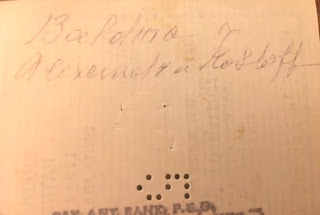
Left: Alexandra Baldina (Kosloff) was a member of the Bolshoi Ballet and later a principal dancer with the Ballets Russes, along with Anna Pavlova and others. Eventually, she came to the United States.
Photo courtesy of Susan Tyne, U.K.
Scroll to the bottom to see a video of Alexandra Baldina and Theodor Kosloff / Koslov performing.
"Cast your bread upon the waters, for you will find it after many days." Ecclesiastes 11:1
Writers knead together assorted words, shape the mass into one form or another, bake it under the heat of scrutiny and revision, and -- sometimes -- release it upon the tides of publication. Most often the words are carried away -- perhaps lost in the vast ocean of words, perhaps run aground on a sandbar somewhere, or perhaps washed up on a remote shore, never to be heard from again.
But once in a very great while . . . .
In 2011, almost eight years ago, I wrote about being part of a long-ago ballet class conducted by Alexandra Baldina, then in her eighties, at a dance studio in Tustin, California. I was not-quite fifteen, growing up in an era of "Hey, Jude," "Born to Be Wild," and "Mrs. Robinson," and I only partially comprehended what an extraordinary opportunity it was.
Baldina had been one of the four principal dancers -- the other three being Anna Pavlova, Vaslav Nijinsky, and Tamara Karsavina -- who first performed Mikhael Fokine's Les Sylphides as part of Sergei Diaghilev's Ballets Russes in 1909, in an era of radical change in art and in world politics.
Miss Irene Wilson, the owner of the Montmarte School of Imperial Russian Ballet where I attended in the late 1960s, had studied under Baldina many years prior, and Baldina had visited her studio on a day my class was scheduled. Quite literally, we were, in that lesson, dancing with one who had danced with Pavlova.
In the process of writing the post about the class, I searched for links to articles about Miss Irene and about Alexandra Baldina and especially for a picture of her. Eventually, I traced one to Susan Tyne, at the time a Grades Examiner for the Royal Academy of Dance, whose grandmother also had been a student of Baldina's. Susan sent me a digital copy of a photo Baldina had given her grandmother, and I included it in the blog post, published on February, 25, 2011.
And that was that. The words floated away, and they never came back.
Until July 2, 2014, that is, when an Anonymous someone left a comment on the post that she, also, had been in that class and had Baldina's signature. I responded and left my email address, but didn't hear anything further until August 2015, when the same person left another message, this time with a name: Paula Hoffman.
Hoffman wrote, "I studied and taught with Miss Irene for years, and I am still using what she taught me all the time. Had a class tonight in fact, and a chat with my teacher after the class about my training and how it intertwines with his teaching. I also had classes with Nana Gollner, also a Kosloff student, and Paul Petroff. Amazing, we were learning the real thing."
Again, I responded, but there was no further reply.
I understood. Email hackers and cyber frauds abound. Neither of us had any assurance the other was legitimately who we claimed to be.
In January 2017, out of the blue, another reader emailed me the link to the video below, which he said had just been posted to YouTube. The video features Baldina and Theodore Kosloff, who later became Baldina's husband during a short-lived marriage, in a joyful pas de deux. This time, I was the one who dropped the ball by neglecting to even thank him for sending it. The email sat there, unacknowledged, until I began writing this post.
 |
Baldina's signature endorsement on the back of the check
Paula Hoffman used to pay for the lesson that day.
Photo courtesy of Paula Hoffman.
|
Patton's comment prompted Hoffman to email me directly, as well, and to send the two images included in this post--a picture of students doing center work in the studio and a picture of Alexandra Baldina Kosloff's signature endorsement on the back of the check Hoffman used to pay for the class that day, April 27, 1968.
The cost of a lesson with one who had danced with Pavlova and Nijinsky? $3.50.
The words I wrote in 2011 had floated out into the blogosphere where at least two other people who had occupied that same place and time fifty years ago had read them. The three of us had, in the strength of that memory, reconnected and had celebrated Miss Irene and Madame Baldina. We were older than Miss Irene was at the time of the lesson, though not as old as Baldina. But still we danced, sometimes with our bodies, always in our hearts.
Such is the power of dance and of words . . . and of words about dance.
Postscript: In my searching for information about Alexandra Baldina, I also connected with Patricia Kaye Dienhart, adjunct dance faculty at BYU in Rexburg, Idaho. Dienhart's CV says she studied under Baldina from 1962-1971 and toured during that time with the Fremont City Ballet under Baldina's direction. I also discovered that my original post had been linked to a page about Baldina on The Dance History Project of Southern California's web site. I had had no idea.



